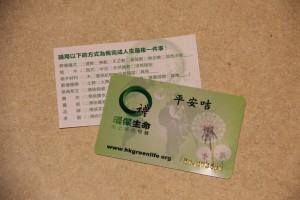However, the effectiveness of such a requirement in promoting green funerals is questionable. According to the statistics of the FEHD, there are around 40,000 deaths every year but only around 1,000 funerals involve eco-coffins. This low number – just 2.5 per cent of all funerals – illustrates the lack of popularity of eco-coffins and green funerals.

Eric Chan Wai-man, chief operating officer of Green Life Passage, says that while the government claims to promote eco-coffins, there are loopholes in the licensing condition. For starters, it does not provide for a qualitative assessment of the provision of eco-coffins. Chan says undertakers can simply fulfill the licensing condition by merely showing photos of the eco-coffin to customers, or even mentioning it verbally.
“Even for those funeral parlours that have a showroom for coffins, they will not show you a paper coffin. If you were a customer, can you purchase a paper coffin? You cannot even see the product; how can you choose the paper coffin?” asks Lam.

Moreover, this licensing condition does not include a definition of what an eco-coffin is. Most of the eco-coffins in funeral parlours look very similar to hardwood coffins, with a carved shape on top and decorations around it. It requires a large amount of paper to produce such an appearance and it is questionable just how environmentally friendly such coffins can be.
Green Life Passage is also frustrated with the government’s response to a mourning clothes recycling programme it proposed in 2013. The company wants to collect mourning clothes in the crematoria for reuse but has yet to receive a formal affirmative reply from the government. Chan explains the FEHD is responsible for the management of cemeteries and crematoria, while the Environmental Protection Department (EPD) is in charge of recycling. He says the departments have pushed back and forth the responsibility of dealing with the programme.
In response to the negative comments on the government’s policies and promotion, Robert Lai Chi-ho, health inspector (cemeteries and crematoria) from the FEHD, says the government has been striving to promote the use of eco-coffins.
Lai says the FEHD has stepped up publicity to promote the use of eco-coffins through various channels, such as publicity leaflets. However, he adds that his department has no power over other whether other governmental departments distribute the leaflets or not.
Despite all the challenges to the development of green funerals in Hong Kong, advocates are still hopeful. Although Kitty Yeung ended up deferring to her mother’s wishes in organising a Buddhist funeral, she believes it is a matter of time before people will come around to accepting green funerals. “It also took many years to accept the idea of cremation, but now many people will choose cremation,” she says.
Leung Tin-yin, who did choose a green funeral for her mother, puts it this way, “I think humans use up many of the earth’s resources over their whole life. In the final stage, we should save whatever can be saved, in order to make the sustenance of life on earth more possible.”
Edited by Charlene Kwan






































